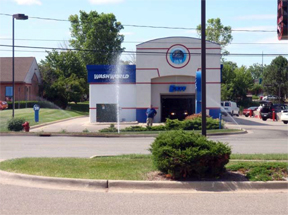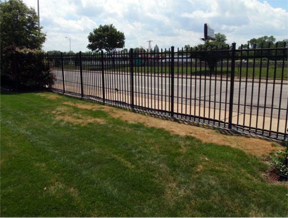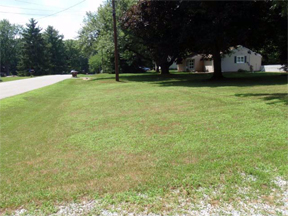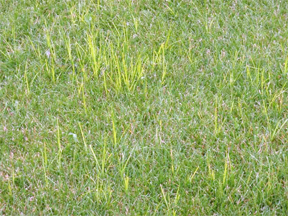Stresses adding up on lawns
Editor’s note: This article is from the archives of the MSU Crop Advisory Team Alerts. Check the label of any pesticide referenced to ensure your use is included
Just as with golf courses, there are plenty of stresses adding up to cause turfgrass decline for high cut turf whether it be home lawns, commercial sites, or corporate complexes. I think it’s important to keep in mind during this summer that when looking at a stressed turfgrass, don’t always assume it’s a disease or insect. I think in many cases you might be seeing a combination of multiple stresses that are causing the turfgrass to just look ugly. Rainfall has been sporadic and heavy, but some areas have actually had some pretty lengthy dry stretches that have exposed poor irrigation coverage.
Due to the high relative humidity, turfgrass diseases have been plenty. Dollar spot and red thread seem to have been active for months now and grubs are just starting to feed so be vigilant in scouting. The rainfall has also kept the turfgrass growing even when air temperatures are high and high rainfall events have likely leached some of the applied fertilizer nitrogen. Many turfgrass areas appear hungry and there has been plenty of pressure from weeds and diseases such as white clover, black medic and red thread that indicate low fertility levels in turf. If the turf is thinning and crabgrass, dollar spot, and red thread are taking over, you may need an additional fertilizer application to give the turf a boost.
The combination of high air temperatures and rainfall throughout the summer has resulted in what appears to be a never-ending period of crabgrass germination. It is impossible to predict a late germinating crabgrass year. Even applicators that properly timed their preemergence applications based on soil temperatures are likely to have breaks this year due to the hot, wet summer. The result is that many (properly timed) preemergence applications did not prove effective. The high temperatures have also resulted in what some might describe as crabgrass on steroids. The large, spreading crabgrass plants are more evident than ever and have many looking for some postemergence control options.
Metharsenate (MSMA) was the standard in the industry for years. It is no longer available. If you still have some in inventory, you may use it. It will likely take two applications (higher temperatures equal better control).
Fenoxaprop-p-ethyl (Acclaim Extra) provides good to excellent crabgrass control up to the three-tiller growth stage. Fenoxyprop offers improved efficacy and turf safety over MSMA. As crabgrass matures or becomes drought stressed, the efficacy of this product decreases. Fenoxyprop-p-ethyl (Acclaim Extra) is not commonly used with 2,4-D as this combination can result in poor weed control and significant cool-season turfgrass injury. The label suggests waiting at least seven days between applications of 2,4-D and Acclaim Extra.
Quinclorac (Drive) may be tank mixed with 2, 4-D or products containing 2, 4-D without antagonism. The added benefit is that there appears to be synergism between 2, 4-D and quinclorac. Quinclorac will control crabgrass beyond the three-tiller growth stage with a single application. Quinclorac also has stand-alone postemergence activity on certain broadleaf weeds, including dandelion, clover, bindweed and speedwell. MSU research has shown increased weed control activity of several broadleaf herbicides by tankmixing them with quinclorac. Increased activity has been seen on ground ivy, speedwell, violets, dandelion and clover. Products containing 2, 4-D have benefited the most from this combination. These combinations deserve consideration to be used for callbacks and mid-to late-summer weed control applications.
One tough nutsedge
When MSMA was used for annual grass control (crabgrass, foxtail, and goosegrass), it also controlled yellow nutsedge. The replacements for MSMA do not have this same broad activity. For instance, quinclorac is excellent on crabgrass and foxtail, but does not control goosegrass or nutsedge. Fenoxaprop has some goosegrass activity, but only on young plants, and no activity on nutsedge. There are several choices for nutsedge. Sulfentrazone and halosulfuron are both excellent nutsedge herbicides and are available as stand-alone products or in premix combination products with annual grass and broadleaf postemergence herbicides. The frequent, heavy rains of May and June will likely result in a bumper crop of nutsedge. Keep your eyes peeled and be patient. Multiple applications are almost always necessary to provide commercially acceptable control.



 Print
Print Email
Email








